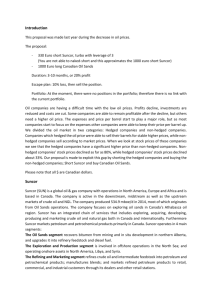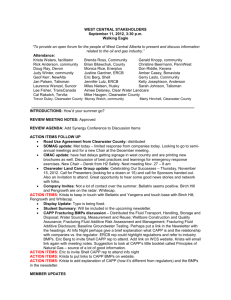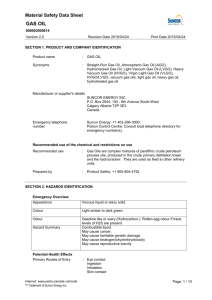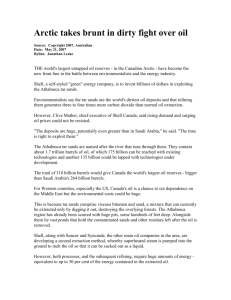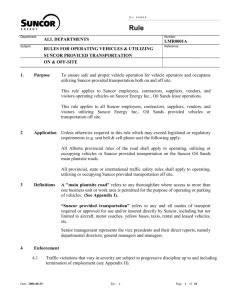NG1-Suncor-bickerton-choy-docherty
advertisement
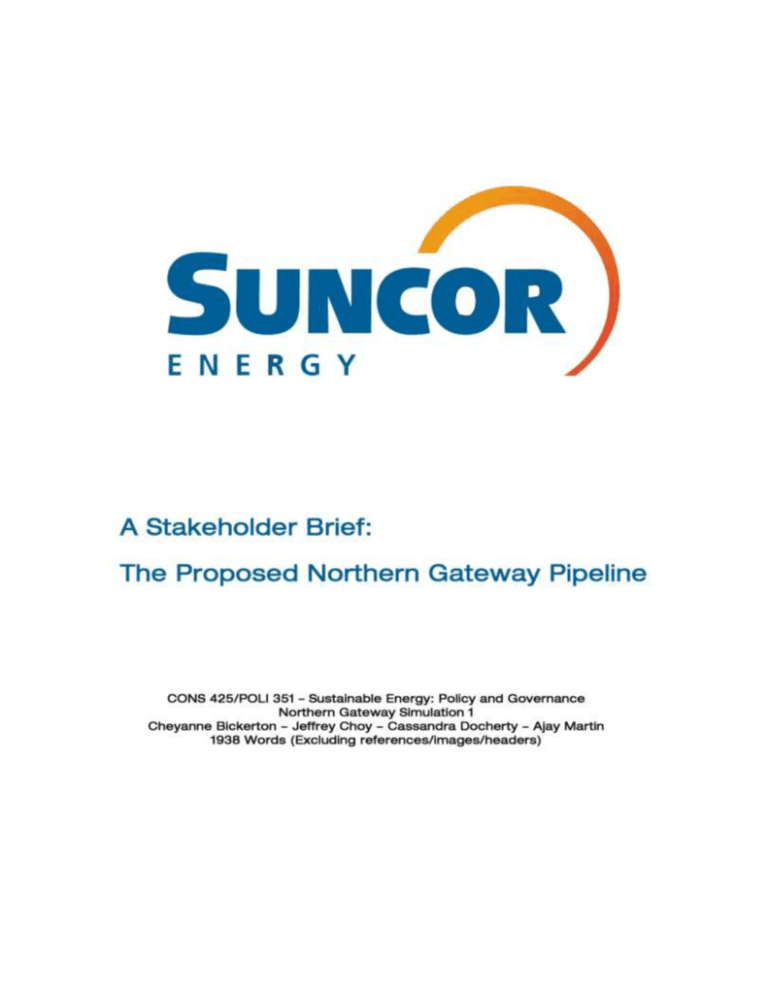
2|Suncor Energy Inc. I. Introduction Canadian pipelines move approximately 1.2 billion barrels of crude oil and petroleum products each year while oil sands production is projected to increase approximately 150% by 2025 to 3.7 million barrels a day from 1.5 million a day in 2010.1 Energy use is continuously trending upwards as the global population and relative wealth of society climbs. Consequently the global demand for oil will continue to grow. Suncor Energy sees this as a strong opportunity for economic growth however the current state of the Canadian pipeline system does not have the capacity to meet the growing energy requirements of these budding economies. In 1967, Suncor pioneered the way for oil sands development in Fort McMurray but have since expanded to become a globally competitive integrated energy company. It is Canada’s largest energy producer and the fifth largest in North America. Suncor is responsible for thousands of jobs as well as support initiatives for local communities, 1 Canadian Energy Pipeline Association via Suncor Energy Inc., "If not pipelines, then what?," Oil Sands Question and Response (blog), Feb 09, 2011, http://osqar.suncor.com/2011/02/if-notpipelines-then-what.html. 3|Suncor Energy Inc. millions of dollars infused into the Canadian economy each year and implementing new environmental technologies. As a strong constituent of the Canadian economy with a large stake in the future of the proposed Enbridge Northern Gateway Pipeline project, it is imperative that Suncor Energy Inc be an integral part of the decision-making process. II. Background i. Triple Bottom Line Suncor is devoted to a triple bottom line, meaning the company measures success with economic, social and environmental considerations. Oil sand revenues for 2010 equated a gain of $681 million in oil sand royalties alone. If plans for growth continue as scheduled, the Canadian government’s tax revenue by 2035 will total $311 4|Suncor Energy Inc. billion. This increase in growth will result in a rise of up to 800,000 possible jobs within the same period of time.2 In addition to a large number of jobs being injected into the Canadian working environment, Suncor is devoted to a positive social impact with citizens and communities. An example is Suncor’s ‘business incubator’ which provides business development loans to start-up aboriginal companies such as Chip Manufacturing and Mikisew Industrial Supply. These two companies contribute to the upwards of $1 billion total spending on goods from Aboriginal companies Suncor is responsible for3. Additionally Suncor is active in supporting positive change in communities surrounding the oil sands through development initiatives such as Social Prosperity Wood Buffalo and Envision Wood Buffalo. These initiatives have allowed for the citizenry of the Regional Municipality of Wood Buffalo to actively partake in the decision-making 2 Suncor Energy Inc., "2011 Report on Sustainability," http://sustainability.suncor.com/2011/pdf/ROS11_E_Final_July14.pdf (accessed February 1, 2012). 3 Anne Harding, Suncor Energy Inc., "Aboriginal-corporate collaborations: ingredients for success," Oil Sands Question and Response (blog), Feb 22, 2012, http://osqar.suncor.com/2012/02/aboriginal-corporate-collaborations-ingredients-forsuccess.html. 5|Suncor Energy Inc. process for managing the regions rapid oil-sand-fueled growth ensuring their needs are met. Suncor also takes a proactive approach when examining environmental issues both regionally and internationally. Suncor is committed to upholding the highest degree of environmental standards, while incorporating new research and innovation, remaining on the forefront of environmentally conscience technological development. Suncor has achieved a complete reclamation of their oldest tailings pond, and continues to make vast improvements in tailing ponds and land reclamation procedures. As a result of the investment in TROTM technology, 7% of total land area, or approximately 1300 ha, used for oil development has been reclaimed over the last 2 years, and is expected to reduce total land area covered by ponds by 80% in the years ahead4. In addition, 75% of the water consumed in surface mining, and 90% of water consumed in in-situ operations, is recycled5. 4 Suncor Energy Inc., "2011 Report on Sustainability," http://sustainability.suncor.com/2011/pdf/ROS11_E_Final_July14.pdf (accessed February 1, 2012). 5 Ibid. 6|Suncor Energy Inc. In exemplifying further commitments to environmental stewardship, water withdrawals from the Athabasca River have been reduced by 36%, which is below 1998 levels, although bitumen production has tripled6. In terms of greenhouse gas emissions, Suncor has reduced emissions intensity by 50% as compared to 1990 levels. Furthermore, Suncor is working towards a reduction of 10% by 2015 of total emissions, as compared to 2007, which is inclusive of dangerous compounds such as nitrous oxide.7 ii. Policy Problem Should the proposal for Northern Gateway Pipeline be rejected, it would present several obstacles to Suncor as a company, and Canada as a whole. Such a proposal would restrict development of Canadian oil sands; Canada has been endowed with an abundance of oil, especially in Alberta, and to not utilize it would deprive Canada and Suncor of financial benefits. This would consequently inhibit Suncor’s ability to 6 Ibid. 7 Ibid. 7|Suncor Energy Inc. contribute to social programs and build sustainable communities. Moreover, Canada would not be able to diversify oil markets and thus be forced to rely more heavily on US markets for energy demands. Currently Canada is only able to export 10,000 barrels a day to markets in China, against China’s projected demand of 11 million barrels a day by 20208. Failure to take advantage of this market could put Canada at a disadvantage globally and deprives the international community of a reliable source of ethically produced petroleum products. 8 Penty, Rebecca. "Alberta Urged to Plan for Chinese Market." Calgary Herald, Jan 24, 2012, http://ezproxy.library.ubc.ca/login?url=http://search.proquest.com/docview/917991840?accounti d=14656 (accessed March 21, 2012). 8|Suncor Energy Inc. III. Evaluative Criteria When considering current energy policy developments it is imperative to take into account the national interests of Canada and its economic state. With this in mind the integral factors for Suncor in evaluating energy development policies concerning the oil sands are: The generation of revenues for Canada’s leading integrated energy company, Suncor The cultivation of economic growth within Canada to ensure a better standard sof life for its citizens Securing Canada’s international presence as a leading energy exporter by building global networks Decreasing economic dependence upon the US 9|Suncor Energy Inc. IV. Evaluation of Possible Outcomes Evaluative Criteria Suncor Energy Encourages Increases Decreases US Inc. Growth Canadian Global Dependence opportunity Economic Exports Growth I. Enbridge Northern Good Good Good Good Neutral Bad Bad Bad Good Good Good Bad Gateway Pipeline II. No major additional pipeline projects III. Keystone XL 10 | S u n c o r E n e r g y I n c . Pipeline i. Enbridge Northern Gateway Pipeline Approved If the Enbridge Northern Gateway Pipeline project were to move forward it would prove beneficial for Canada on multiple different fronts. From a purely economic consideration, Canada stands to gain from the development of the Northern Gateway pipeline a possible $400 billion in added GDP over twenty-five years9 which is the equivalent to 22% of Canada’s current GDP. During this same period the Canadian government has a potential to earn $77 billion in tax revenue coming primarily from oil sand development companies10. On top of increased funding for government social programs and infrastructural upgrades, Canadian citizens benefit in terms of job creation. Twenty-five years following 9 Honarvar, Afshin, Dinara Millington, Jon Rozhon, Thorn Walden, and Carlos A. Murillo. Canadian Energy Research Institute, "Ecconomic Impacts of Staged Development of Oil Sands Projects in Alberta (2010-2035)." Last modified June, 2011. Accessed March 21, 2012. http://www.ceri.ca/images/stories/2011-08-24_CERI_Study_125_Section_1.pdf. 10 Ibid. 11 | S u n c o r E n e r g y I n c . the approval of the pipeline project, Canada would witness an increase of 2.1 million person years of employment11. The increased revenues resulting from the possible approval of the pipeline would moreover enable Suncor to further their already extensive community development initiatives and Aboriginal sponsorship programs. In regards to reducing environmental impact, by exporting oil to China, Canada can help alleviate their large dependence upon coal as a fuel source. Currently 80% of China’s generated electricity comes from coal which contributes to China’s 1.8 billion tons of coal per year usage. Their usage is expected to increase as 86% of incremental world coal demand by of 2030 will come from China and India12. This is alarming from an environmental perspective due to the fact that coal is 33% more carbon-intensive than natural oil13. Exporting Canada’s oil to China would effectively reduce green 11 Ibid. 12 Center for Climate and Energy Solutions, "Coal and Climate Change Facts." Last modified March 19, 2012. Accessed March 21, 2012. http://www.c2es.org/global-warmingbasics/coalfacts.cfm. 13 Crown, Department for Transport, "Carbon and Sustainability Reporting Within the Renewable Transport Fuel Obligation," Government Recommendation to the Office of the Renewable Fuels 12 | S u n c o r E n e r g y I n c . house gas emissions by a significant degree by replacing coal with a lower carbonintensive alternative with the ultimate goal of zero coal-reliance for China in the future. Currently the US accounts for upwards of 97% of Canada’s oil exports14. This leaves Canada’s economy susceptible to market price fluctuations resulting from increased production in the Midwest US region, specifically Cushing, Oklahoma. Furthermore it leaves Canada’s economic fate intrinsically bound to that of the US economy. Given recent history this would prove problematic should the US suffer another economic collapse. ii. No Additional Major Pipeline Projects In the scenario that the pipeline is not met with approval, Suncor will lose the infrastructural capacity of an estimated 525,000 barrels shipped per day, hindering achievement of Suncor’s 2020 goal of 1 million barrels of oil produced daily. Canada Agency, no. Jan (2008), http://webarchive.nationalarchives.gov.uk/ /http://www.dft.gov.uk/pgr/roads/environment/rtfo/govrecrfa.pdf (accessed March 21, 2012). 14 Oil Sands Truth, "Factbox:Enbridge Pipeline to the Pacific: Facts and Issues." Last modified Jan 30, 2012. Accessed March 21, 2012. http://oilsandstruth.org/factbox-enbridge-pipeline-pacificfacts-and-issues. 13 | S u n c o r E n e r g y I n c . stands to possibly lose out on $400 billion in GDP and $77 billion in tax revenue over the next twenty five years that could have come as a result of increased oil sand development. Instead without any additional major pipeline projects, oil sand development will only generate $2.3 billion in terms of Canadian GDP within that period15. The business strategy of relying on existing pipeline systems going forward limits Canada’s possibility of exploration of foreign markets and fails to ease Canada’s American dependence; Canada’s economic growth may suffer as a consequence. If oil sand production were to continue growing at its current pace, an alternative to transportation through pipeline would involve railways. To match the crude oil and refined petroleum product transportation capacity of pipeline projects, it would require 15 Honarvar, Afshin, Dinara Millington, Jon Rozhon, Thorn Walden, and Carlos A. Murillo. Canadian Energy Research Institute, "Ecconomic Impacts of Staged Development of Oil Sands Projects in Alberta (2010-2035)." Last modified June, 2011. Accessed March 21, 2012. http://www.ceri.ca/images/stories/2011-08-24_CERI_Study_125_Section_1.pdf. 14 | S u n c o r E n e r g y I n c . 1500 rail cars a day16. While this may seem like a somewhat viable alternative, the carbon emissions generated would be unacceptable for Canada’s emission goals. iii. Reapplication for the TransCanada Keystone XL Pipeline If the initial option of the Northern Gateway Pipeline is not approved, Suncor would strongly recommend revisiting the proposed TransCanada Keystone XL Pipeline. The Keystone XL pipeline would expand pipeline transportation capacity of bitumen to the US from its current volume of 700,000 barrels per day to 4.2 million barrels per day17. This provides the infrastructural capacity needed to sustain Suncor’s growth as a company allowing for optimal utilization of the oil sands. The number of jobs created by this proposed project would reach a peak of 690,000 jobs while adding $2.8 trillion in 16 Canadian Energy Pipeline Association via Suncor Energy Inc., "If not pipelines, then what?," Oil Sands Question and Response (blog), Feb 09, 2011, http://osqar.suncor.com/2011/02/if-notpipelines-then-what.html. 17 Honarvar, Afshin, Dinara Millington, Jon Rozhon, Thorn Walden, and Carlos A. Murillo. Canadian Energy Research Institute, "Ecconomic Impacts of Staged Development of Oil Sands Projects in Alberta (2010-2035)." Last modified June, 2011. Accessed March 21, 2012. http://www.ceri.ca/images/stories/2011-08-24_CERI_Study_125_Section_1.pdf. 15 | S u n c o r E n e r g y I n c . total GDP within twenty-five years18. This may be a lucrative option but it does little in reducing dependence on the US markets for energy demand. Canada from broadening its international trade presence. Moreover it prevents Nor would it allow for the capturing of the increased demand for energy world-wide which proves so economically promising. V. Recommendation and Conclusion After exploration of several options Suncor finds it in its best interest to offer its endorsement to the construction of the Enbridge Northern Gateway Pipeline project. The approval of this project would fulfill the requirements necessary for Suncor’s prosperity and are imperative to Suncor’s establishment as a globally competitive 18 Ibid. 16 | S u n c o r E n e r g y I n c . force. Tied with Suncor’s arrival onto the international stage is Canada’s emergence as a premier supplier of reliable, ethically-sourced oil. Additionally on the domestic level, the Northern Gateway Pipeline will generate ample employment opportunities for Canadian citizens while allowing Suncor to work towards supporting sustainable communities through employee programmes, charitable donations and sponsorships. It is ultimately the priority of Suncor to support projects that have the best interests of Canada and its citizens, as best exemplified by the Northern Gateway Pipeline. 17 | S u n c o r E n e r g y I n c . Works Cited Department for Transport, Crown. "Carbon and Sustainability Reporting Within the Renewable Transport Fuel Obligation." Government Recommendation to the Office of the Renewable Fuels Agency. no. Jan (2008). /http://www.dft.gov.uk/pgr/roads/environment/rtfo/govrecrfa.pdf (accessed http://webarchive.nationalarchives.gov.uk/ March 21, 2012). Honarvar, Afshin, Dinara Millington, Jon Rozhon, Thorn Walden, and Carlos A. Murillo. Canadian Energy Research Institute, "Ecconomic Impacts of Staged Development of Oil Sands Projects in Alberta (2010-2035)." June, 2011. Accessed March 21, 2012. http://www.ceri.ca/images/stories/2011-08- 24_CERI_Study_125_Section_1.pdf. Oil Sands Truth, "Factbox:Enbridge Pipeline to the Pacific: Facts and Issues." Last modified Jan 30, 2012. Accessed March 21, 2012. http://oilsandstruth.org/factboxenbridge-pipeline-pacific-facts-and-issues. Penty, Rebecca. "Alberta Urged to Plan for Chinese Market." Calgary Herald, Jan 24, 2012, http://ezproxy.library.ubc.ca/login?url=http://search.proquest.com/docview/9179 91840?accountid=14656 (accessed March 21, 2012). 18 | S u n c o r E n e r g y I n c . Suncor Energy Inc. "If not pipelines, then what?." Oil Sands Question and Response (blog), Feb 09, 2011. http://osqar.suncor.com/2011/02/if-not-pipelines-then-what.html (accessed Feb 1, 2012). Suncor Energy Inc. "2011 Report on Sustainability."Suncor Company Website . http://sustainability.suncor.com/2011/pdf/ROS11_E_Final_July14.pdf (accessed February 1, 2012). Suncor Energy Inc., Harding, Anne. "Aboriginal-corporate collaborations: ingredients for success." Oil Sands Question and Response (blog), Feb 22, 2012.http://osqar.suncor.com/2012/02/aboriginal-corporate-collaborationsingredients-for-success.html (accessed March 5, 2012). 19 | S u n c o r E n e r g y I n c .


